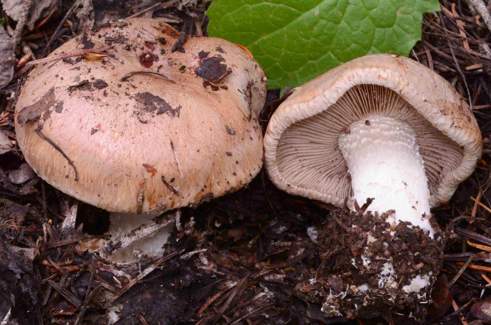 Hebeloma albomarginatum (Photo: N. Siegel)
Hebeloma albomarginatum (Photo: N. Siegel)Taxonomy
Full name: Hebeloma albomarginatum Hesler, Kew Bulletin 31 (3): 471 (1977)Genus: Hebeloma
Section: Sinapizantia
Types: UNITED STATES: Tennessee: Blount, Townsend, Cades Cove (approx. 35.6019°N, 83.8114°W, alt. approx. 550 m a.s.l.), 30 Sep. 1966, L.R. Hesler (Holotype. herbarium acc. no. TENN-F-029405, HJB1000309).
Heterotypic synonyms:
- Hebeloma insigne A.H. Sm., V.S. Evenson & Mitchel, The Veiled Species of Hebeloma in the Western United States: 132 (1983)
- Hebeloma megacarpum A.H. Sm. ex Grilli, Beiträge zur Kenntnis der Pilze Mitteleuropas 14: 83 (2005)
- Hebeloma wells-kemptoniae A.H. Sm., V.S. Evenson & Mitchel [as "wells-kemptonae"], The Veiled Species of Hebeloma in the Western United States: 135 (1983)
- arrow_drop_downarrow_drop_upEtymology
- arrow_drop_downarrow_drop_upOriginal diagnosisPileus 3-5 cm latus, pallide sordido-cinnamomeus margine albus, viscidus, fibrillosus. Contextus albus; odor et gustus raphanoideus. Lamellae rotundoadnatae, albae deinde brunnescentes, confertae, medio-angustae. Stipes 1-2.5 cm longus, 8-16 mm crassus, albus, supra squamosus, leviter bulbosus, siccus. Velum deest. Sporae 9-12 x 6-7.5-(8) μm, subovoideae demum subfusoideae, asperulatae, calyptratae. Pleurocystidia desunt; ceilocystidia 38-68 x 5-10 μm ventricosa. Pilei trama radiale. Hypodermium ex hyphis radialibus compositum. (P1. 16; Figs. IA-C.)
- arrow_drop_downarrow_drop_upEnglish translationPileus 3-5 cm broad, pale dingy cinnamon, with white margin, viscid, fibrillose. Context white; smell and taste raphanoid. Lamellae rounded-adnate, white then becoming brownish, crowded, medium narrow. Stipe 1-2.5 cm long, 8-16 mm thick, white, squamose above, slightly bulbous, dry. Veil none. Spores 9-12 x 6-7 (8) μm, subovoid then subfusoid, roughened, calyptrate. Pleurocystidia none; cheilocystidia 38-68 x 5-10 μm ventricose. Pileus trama radial. Hypoderm made up of radially arranged hyphae. (Pl. 16; Figs. IA-C).
References
Description
- arrow_drop_downarrow_drop_upThresholds
Description of Hebeloma albomarginatum based on 55 collections
- arrow_drop_downarrow_drop_upMacroscopic descriptionPileus: (30) 44–144 (155) mm diameter; shape often convex, occasionally broadly umbonate or umbonate, rarely applanate; characters often remains of universal veil, occasionally pubescent, rarely rugulose; margin characters often involute, occasionally scalloped or fibrillose, rarely smooth, reflexed or sulcate; viscosity tacky when moist; colour variation often unicolour, occasionally two color; colour at centre occasionally cinnamon, rarely greyish brown, ochraceous, brick, yellowish brown, dark pinkish buff, clay-buff, fawn, clay-pink or clay-red.
Lamellae: attachment usually emarginate, occasionally adnexed, rarely adnate; maximum depth 6–9 mm; number of complete lamellae 84–146; presence of tears usually visible with naked eye, rarely absent; white fimbriate edge present.
Cortina presence: no.
Stipe: (10) 37–114 (120) x (8) 11–22 (30) {median} x (10) 15–33 (40) {basal} mm; stipe Q 1.3–9.5; base shape often clavate, occasionally cylindrical or bulbous; floccosity usually floccose, often floccose at apex, rarely pruinose at apex; rooting no; thick rhizoids at base often absent, occasionally present;
Context: Texture firm; stipe interior often hollow or superior wick, occasionally basal wick, rarely stuffed; stipe flesh discolouring no; slenderness measure 0.6–15.4; smell often raphanoid, rarely cocoa, strongly raphanoid, odourless or weakly raphanoid; taste often mild, occasionally none where recorded.
Spore deposit colour: often brownish olive, occasionally umber or yellowish brown.
Exsiccata characters: Not recorded.
- arrow_drop_downarrow_drop_upMicroscopic descriptionSpores: shape amygdaloid or limoniform; colour in microscope usually brown, occasionally yellow brown; guttules often no, occasionally yes. papilla very strongly; Spore Code: O3 O4; P2 P3; D3 D4.
Basidia: (26) 27–40 (41) x 7–9 (10) μm; ave. Q 3.5–4.6; spore arrangement usually 4 spored, rarely variable;
Cheilocystidia: main shape gently clavate, usually clavate-lageniform or clavate-ventricose, occasionally clavate-stipitate or ventricose, rarely lageniform; special features observed often septa, occasionally bifurcate or conglutinate, rarely sinuate or yellow contents; cheilocystidia ratios: A/M = 1.43–1.89; A/B = 1.16–2.30; B/M = 0.76–1.32.
Pleurocystidia: none seen.
Ixocutis: epicutis thickness (measured from exsiccata) up to 185 μm; ixocutis hyphae width up to 9 μm; ixocutis hyphae encrustation variable; shape of trama elements beneath subcutis cylindrical, occasionally ellipsoid, isodiametric or thickly sausage-shaped up to 18 μm wide.
Caulocystidia: Similar to cheilocystidia but larger, up to 170 μm.
- arrow_drop_downarrow_drop_upSpore measurements
- arrow_drop_downarrow_drop_upCheilocystidia measurements
- arrow_drop_downarrow_drop_upHabitat and distributionHebeloma albomarginatum's preferred habitat appears to be mixed woodland with soil or grassy, mossy soil. Where only one possible associate was recorded, the most commonly recorded associate was Populus (29.4%) but Picea (29.4%), Quercus (23.5%), Pinus (5.9%), Tilia (5.9%) and Abies (5.9%) were also recorded. In these cases the most commonly recorded families were Pinaceae (52.2%), Salicaceae (26.1%) and Fagaceae (17.4%). We have additional records where Salix (14.6%), Alnus (4.9%), Betula (4.9%), Carya (2.4%), Arbutus (2.4%), Fagus (2.4%) and Tsuga (2.4%) were recorded as possible associates, but in these cases a number of possible associates were mentioned. Overall the most commonly recorded families are Pinaceae (63.4%), Salicaceae (43.9%) and Fagaceae (19.5%) The growth habit of our collections was often scattered, occasionally gregarious or solitary and rarely caespitose.
According to our current collections, the species is found only in Northern America. On the continent, collections has been found in the WWF biomes The World Wildlife Fund (WWF) have divided the world into 867 terrestrial ecoregions. The ecoregion here is estimated by mapping from the GPS coordinates of the collection using data made available by Dinerstein et al (2017). Use this webtool to explore the ecoregions visually or see a full list of current ecoregions on Wikipedia. temperate conifer forests (47.3%), temperate broadleaf & mixed forests (21.8%) and boreal forests/taiga (21.8%), specifically including the ecoregions: Arizona Mountains forests (14.5%) and Colorado Rockies forests (12.7%). From collector information, it appears collections have been found in the 1.1 Forest – Boreal (45.7%) and 1.4 Forest – Temperate (37.1%) IUCN habitats We map from the collector's description of the habitat to the International Union for Conservation of Nature (IUCN)'s definition using a standardised set of rules. Please see this page for a full list of IUCN habitats.. Within Northern America we have records from Southwestern U.S.A. (Arizona and California), Northwestern U.S.A. (Colorado, Washington and Oregon), Subarctic America (Yukon and Alaska), Western Canada (Alberta and British Columbia), North-central U.S.A. (Minnesota, Wisconsin and Missouri), Eastern Canada (Quebec and Ontario), Northeastern U.S.A. (Ohio and Michigan) and Southeastern U.S.A. (Tennessee).
Geographic distribution
Phenology
- arrow_drop_downarrow_drop_upAdditional cited collections